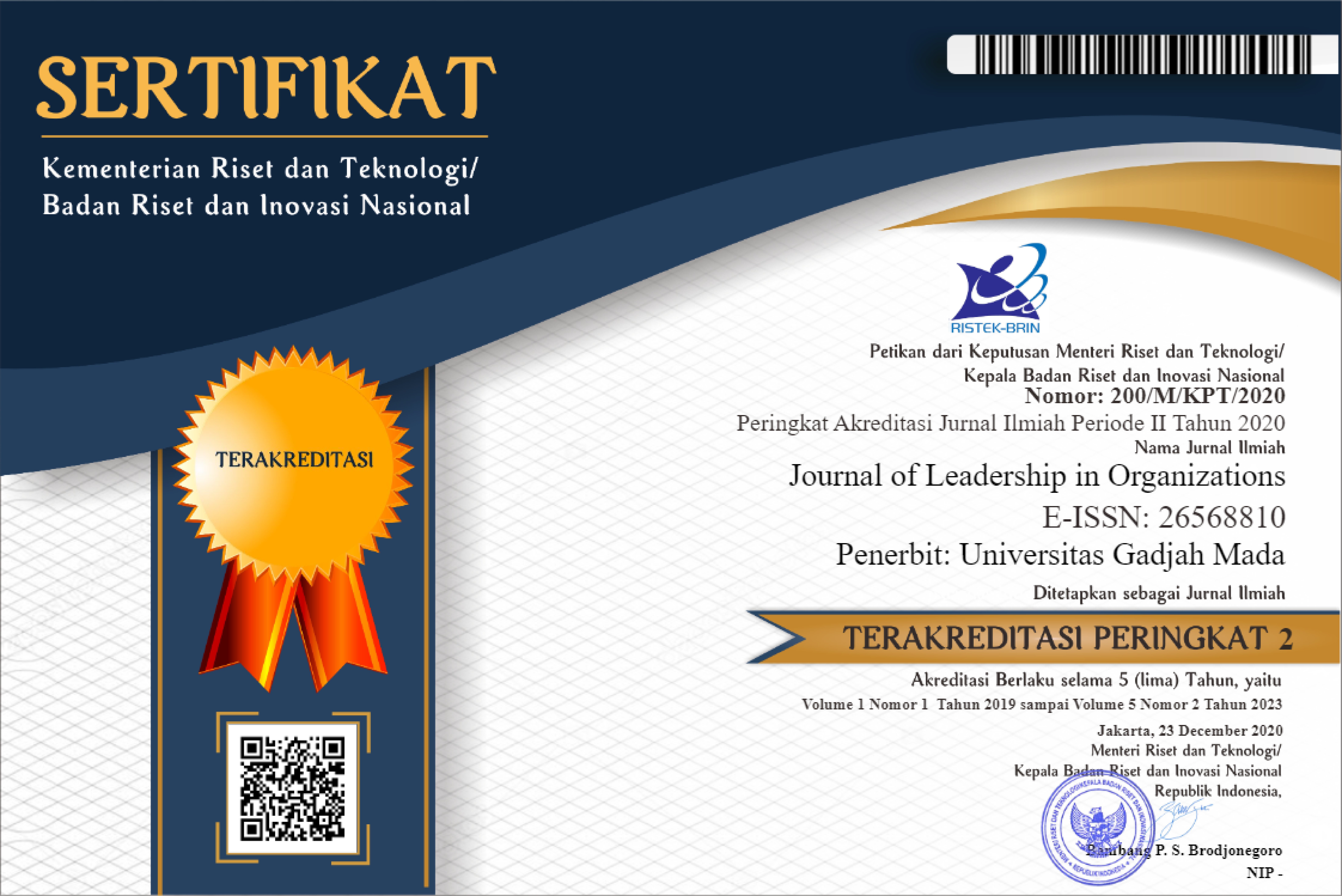Neural Correlates of the Dual-Level Transformational Leadership Model
Katharina Leifker(1), Mathias Diebig(2), Ute Poethke(3), Jens Rowold(4*)
(1) Ecotel communication ag, Prinzenallee 11, 40549 Düsseldorf, NRW, Germany
(2) Heinrich Heine University Düsseldorf, Medical Faculty, Germany
(3) Hochschule für Polizei und öffentliche Verwaltung, Gelsenkirchen, NRW, Germany
(4) Center for Higher Education, TU Dortmund University, Dortmund, NRW, Germany
(*) Corresponding Author
Abstract
Introduction/Main Objectives: This study considered neural processes of transformational leadership based on quantitative electroencephalography (qEEG). Background Problems: This research aims at providing biomarkers for effective (i.e., transformational) leadership. Novelty: We considered transformational leadership on a detailed level, namely its individual-focused and group-focused sub-dimensions, to analyze the underlying brain processes. As for the individual-focused sub-dimensions of transformational leadership, we utilized innovation and performance orientation, while for the group-focused sub-dimensions, we choose vision and team spirit. Research Methods: Fifty-two dyads, consisting of (a) student pairs and (b) supervisor-subordinate dyads, participated in a simulated role-play that was intended to be a performance review while the electrical activity of the brain was recorded. Finding/Results: Results show that the group-focused sub-dimensions of transformational leadership could be positively linked to right frontal lobe coherence and negatively linked to left frontal lobe coherence. Results showed no relation between the individual-focused sub-dimensions and frontal lobe coherence. Conclusion: The results allow for a deeper understanding of the neural processes of transformational leadership and its individual-focused and group-focused sub-dimensions, respectively.
Keywords
Full Text:
PDFReferences
Anderson, S. W., Damasio, H., Jones, R. D. and Tranel, D. (1991). Wisconsin Card Sorting Test performance as a measure of frontal lobe damage. Journal of Clinical and Experimental Neuropsychology, 13(6), 909–922.
Balthazard, P. A., Waldman, D. A., Thatcher, R. W. and Hannah, S. T. (2012). Differentiating transformational and non-transformational leaders on the basis of neurological imaging, The Leadership Quarterly, 23(2), 244–258.
Bass, B. M. (1985). Leadership and performance beyond expectations, New York, Free Press.
Buckner, R. L., Andrews-Hanna, J. R. and Schacter, D. L. (2008). The brain's default network: Anatomy, function, and relevance to disease. Annals of the New York Academy of Sciences, 1124, 1–38.
Burgess, P. W., Veitch, E., de Lacy Costello, A. and Shallice, T. (2000). The cognitive and neuroanatomical correlates of multitasking, Neuropsychologia, 38(6), 848–863.
Burton, M. W., Small, S. L. and Blumstein, S. E. (2000). The role of segmentation in phonological processing: An fMRI investigation, Journal of Cognitive Neuroscience, 12(4), 679–690.
Currie, G. and Lockett, A. (2007). A critique of transformational leadership: Moral, professional and contingent dimensions of leadership within public services organizations. Human Relations, 60(2), 341–370.
Decety, J., Jackson, P. L., Sommerville, J. A., Chaminade, T. and Meltzoff, A. N. (2004). The neural bases of cooperation and competition: An fMRI investigation, NeuroImage, 23(2), 744–751.
Delgado, M. R., Nearing, K. I., LeDoux, J. E. and Phelps, E. A. (2008). Neural circuitry underlying the regulation of conditioned fear and its relation to extinction, Neuron, 59(5), 829–838.
Delorme, A. and Makeig, S. (2004). EEGLAB: An open source toolbox for analysis of single-trial EEG dynamics including independent component analysis. Journal of Neuroscience Methods, 134, 9–21.
Dong, Y., Bartol, K. M., Zhang, Z. X. and Li, C. (2017). Enhancing employee creativity via individual skill development and team knowledge sharing: Influences of dual‐focused transformational leadership, Journal of Organizational Behavior, 38(3), 439–458.
Dumontheil, I. (2014). Development of abstract thinking during childhood and adolescence: the role of rostrolateral prefrontal cortex, Developmental cognitive neuroscience, 10, 57–76.
Hatfield, E., Cacioppo, J. T. and Rapson, R. L. (1993). Emotional Contagion, Current Directions in Psychological Science, 2(3), 96–100.
Hellige, J. B. (1990). Hemispheric asymmetry, Annual review of psychology, 41(1), 55–80.
Hogg, M. A. (2001). A social identity theory of leadership, Personality and Social Psychology Review, 5(3), 184–200.
Jasper, H. H. (1958). The ten twenty electrode system of the international federation, Electroencephalography and Clinical Neurophysiology, 10, 371–375.
Johnson, R. E., Venus, M., Lanaj, K., Mao, C. and Chang, C.-H. (2012). Leader identity as an antecedent of the frequency and consistency of transformational, consideration, and abusive leadership behaviors. Journal of Applied Psychology, 97(6), 1262–1272.
Kark, R. and Shamir, B. (2002). The dual effect of transformational leadership: Priming relational and collective selves and further effects on followers, in Avolio, B. J. and Yammarino, F. J. (Eds.), Transformational and charismatic leadership. The road ahead (6–94), Emerald Bingley.
Kelloway, E. K. and Barling, J. (2010). Leadership development as an intervention in occupational health psychology, Work & Stress, 24(3), 260–279.
Lacerenza, C. N., Reyes, D. L., Marlow, S. L., Joseph, D. L. and Salas, E. (2017). Leadership training design, delivery, and implementation: A meta-analysis. Journal of Applied Psychology,102(12), 1686–1718.
Lee, N., Senior, C. and Butler, M. J. (2012). The domain of organizational cognitive neuroscience: Theoretical and empirical challenges. Journal of Management, 38(4), 921–931.
Lehmann-Willenbrock, N., Meinecke, A. L., Rowold, J. and Kauffeld, S. (2015). How transformational leadership works during team interactions: A behavioral process analysis. The Leadership Quarterly, 26(6), 1017–1033.
Leslie, A. M. (1987). Pretense and representation: The origins of "theory of mind"’, Psychological Review, 94(4), 412–426.
McClean, S. T., Barnes, C. M., Courtright, S. H. and Johnson, R. E. (2019). Resetting the clock on dynamic leader behaviors: A conceptual integration and agenda for future research. The Academy of Management Annals, 13(2), 479–508.
Mognon, A., Jovicich, J., Bruzzone, L. and Buiatti, M. (2011). ADJUST: An automatic EEG artifact detector based on the joint use of spatial and temporal features, Psychophysiology, 48(2), 229–240.
Molenberghs, P. and Morrison, S. (2014). The role of the medial prefrontal cortex in social categorization. Social Cognitive and Affective Neuroscience, 9(3), 292–296.
Morcom, A. M. and Fletcher, P. C. (2007). Does the brain have a baseline? Why we should be resisting a rest. NeuroImage, 37, 1073–1082.
Mumford, M. D., Friedrich, T. L., Caughron, J. J. and Antes, A. L. (2009). Leadership research: Traditions, developments, and current directions. The Sage handbook of organizational research methods (111–127). Sage: London
Nee, D. E., Jahn, A. and Brown, J. W. (2014). Prefrontal cortex organization: dissociating effects of temporal abstraction, relational abstraction, and integration with FMRI, Cerebral Cortex, 24(9), 2377–2387.
Nielsen, K. and Daniels, K. (2012). Does shared and differentiated transformational leadership predict followers, working conditions and well-being? The Leadership Quarterly, 23(3), 383–397.
Ocklenburg, S. and Gunturkun, O. (2018). The lateralized brain: The neuroscience and evolution of hemispheric asymmetries. London, Academic Press.
Pascalis, V. de, Cozzuto, G., Caprara, G. V. and Alessandri, G. (2013). Relations among EEG-alpha asymmetry, BIS/BAS, and dispositional optimism. Biological psychology, 94(1), 198–209.
Podsakoff, P. M., MacKenzie, S. B. and Bommer, W. H. (1996). Transformational leader behaviors and substitutes for leadership as determinants of employee satisfaction, commitment, trust, and organizational citizenship behaviors. Journal of Management, vol. 22(2), 259–298.
Podsakoff, P. M., MacKenzie, S. B., Moorman, R. H. and Fetter, R. (1990). Transformational leader behaviors and their effects on followers' trust in leader, satisfaction, and organizational citizenship behaviors. The Leadership Quarterly, 1(2), 107–142.
Raichle, M. E. (2010). Two views of brain function. Trends in Cognitive Sciences, 14(4), 180–190.
Riedl, R. and Javor, A. (2012). The biology of trust: Integrating evidence from genetics, endocrinology, and functional brain imaging. Journal of Neuroscience, Psychology, and Economics, 5(2), 63–91.
Robinson, G. A., Cipolotti, L., Walker, D. G., Biggs, V., Bozzali, M. and Shallice, T. (2015). Verbal suppression and strategy use: a role for the right lateral prefrontal cortex? Brain: A Journal of Neurology, 138(4), 1084–1096.
Rowold, J. and Poethke, U. (2017). Fragebogen zur integrativen Führung. Hogrefe, Göttingen.
Scharnowski, F. and Weiskopf, N. (2015). Cognitive enhancement through real-time fMRI neurofeedback. Current Opinion in Behavioral Sciences, 4, 122–127.
Schurz, M., Radua, J., Aichhorn, M., Richlan, F. and Perner, J. (2014). Fractionating theory of mind: a meta-analysis of functional brain imaging studies. Neuroscience and Biobehavioral Reviews, 42, 9–34.
Thatcher, R. W., Krause, P. J. and Hrybyk, M. (1986). Cortico-cortical associations and EEG coherence: A two-compartmental model, Electroencephalography and Clinical, vol. 64(2), 123–143.
Thatcher, R. W., North, D. and Biver, C. (2005). EEG and intelligence: Relations between EEG coherence, EEG phase delay and power. Clinical Neurophysiology, 116(9), 2129–2141.
Tzourio-Mazoyer, N. and Seghier, M. L. (2016). The neural bases of hemispheric specialization. Neuropsychologia, 93, 319–324.
van Knippenberg, D. and Sitkin, S. B. (2013). A critical assessment of charismatic—transformational leadership research: Back to the drawing board? The Academy of Management Annals, 7(1), 1–60.
Vogel, D. and Jacobsen, C. B. (2021). Nonresponse bias in public leadership research: an empirical assessment. International Public Management Journal, 24(3), 435–454.
Waldman, D. A., Balthazard, P. A. and Peterson, S. (2011a). Leadership and Neuroscience: Can we revolutionize the way that leaders are identified and developed? Academy of Management Perspectives, 25(1), 60–74.
Waldman, D. A., Balthazard, P. A. and Peterson, S. J. (2011b). Social cognitive neuroscience and leadership. The leadership quarterly, 22(6), 1092–1106.
Waldman, D. A., Wang, D., Hannah, S. T. and Balthazard, P. A. (2017). A Neurological and Ideological Perspective of Ethical Leadership. Academy of Management Journal, 60(4), 1285–1306.
Waldman, D. A., Wang, D., Hannah, S. T., Owens, B. P. and Balthazard, P. A. (2018). Psychological and neurological predictors of abusive supervision. Personnel Psychology, 71(3), 399–421.
Wang, D., Waldman, D. A., Balthazard, P. A., Stikic, M., Pless, N. M., Maak, T., ... & Richardson, T. (2021). Applying neuroscience to emergent processes in teams. Organizational Research Methods, 24(3), 595-615.
Wang, G., Oh, I.-S., Courtright, S. H. and Colbert, A. E. (2011). Transformational leadership and performance across criteria and levels: A meta-analytic review of 25 years of research. Group & Organization Management, 36(2), 223–270.
Wang, X. H. and Howell, J. M. (2010). Exploring the dual-level effects of transformational leadership on followers. Journal of Applied Psychology, 95(6), 1134–1144.
Note. A former version of this manuscript is part of the doctoral thesis of the first author and is published online at the document repository Eldorado, i.e., the electronic platform for academic publications of TU Dortmund University.
Article Metrics
Refbacks
- There are currently no refbacks.
Copyright (c) 2024 Journal of Leadership in Organizations

This work is licensed under a Creative Commons Attribution-ShareAlike 4.0 International License.
| Journal of Leadership in Organizations |
| Journal of Leadership in Organizations (JLO), with registered number ISSN 2656-8829 (Print) and ISSN 2656-8810 (Online), is published by the Center for Leadership Studies, Department of Management, Faculty of Economics and Business, Universitas Gadjah Mada. The content of this website is licensed under a Creative Commons Attribution-ShareAlike 4.0 International License |
| © 2019 Journal of Leadership in Organizations | |





_logo2.png)


.png)




